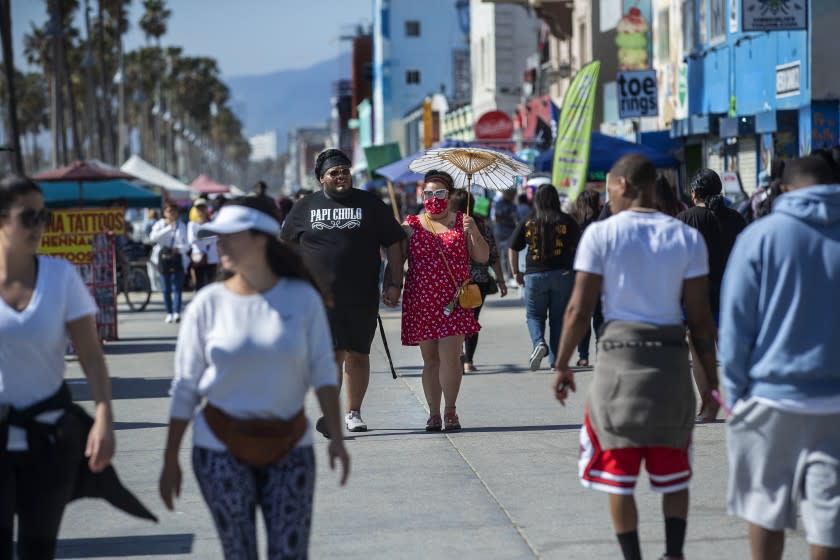California's COVID-19 'honeymoon' has been glorious. But it could end soon

Is California headed toward a spring COVID-19 surge?
At first glance, the data looks promising for avoiding one. California's number of average daily coronavirus cases is down 16% over the past two weeks, falling to fewer than 3,000 cases a day. And COVID-19 hospitalizations in California are down 28% from two weeks ago.
But experts and public health officials are increasingly alarmed that increases in cases being seen in parts of the U.S. and Europe could eventually threaten California's progress.
"Certainly in California, there's a very good chance that we're going to have a brief honeymoon, and then it will get worse again. I wouldn't be surprised," said Dr. Stefano Bertozzi, professor of health policy and dean emeritus of the UC Berkeley School of Public Health, said at a UC San Francisco forum last week.
A potential big nightmare would result from the wide spread of variants like the kind that has struck Brazil. The Brazilian city of Manaus was one of the hardest hit in the world with the conventional strain of the coronavirus, "and now it appears that there's lots of reinfection with the new Brazilian variant. So I'm worried about out what happens in the future," Bertozzi said. "There is a future in which this goes on for much longer than we hope," such as if the wrong variant becomes prolific. Already, some of the monoclonal antibody treatments used to treat COVID-19 seem to be less effective against some of the new variants.
To be sure, California has much going for it compared with the nation as a whole, as well as with states that are seeing an increase in coronavirus cases, like Michigan and Florida and in the Northeast. Of more than 27,000 virus samples that have been genomically sequenced in California, only six are of the Brazilian "variant of concern" known as P.1. Some suspect that P.1 will eventually be overtaken by the more contagious U.K. variant to dominate California. And while California's coronavirus positivity rate over the last seven days is 1.5%, it's 8.3% in New Jersey, 8.8% in Florida and 12.6% in Michigan.
But in the past year, California hasn't been able to wall itself forever against surges of COVID-19 that appear elsewhere in the country. “This past year indicates that often the East Coast experiences increases in cases before the West Coast and that, typically, L.A. County is a few weeks behind New York,” Los Angeles County Public Health Director Barbara Ferrer said last week.
Not everyone thinks that California is necessarily doomed to follow the path of other states. Factors that could help California include just how low disease transmission has plunged in many areas of the state. That could help buy the state more time to get more vaccine shots in arms before another surge can happen.
Here are several things to consider about how the nation and California might fare in the coming weeks.
It's clear some areas in California are seeing an increase in crowds as economic restrictions are eased and spring break arrives. The Easter Sunday holiday is going be a big test of whether California can avoid another spike, experts say.
Dr. Rochelle Walensky, director of the U.S. Centers for Disease Control and Prevention, sounded the alarm Monday about a sudden rise in weekly coronavirus cases.
The nation is now seeing 60,000 new coronavirus cases a day over the past week — an alarming 10% increase compared with the previous week, when there were about 54,000 new coronavirus cases a day. Previously, daily coronavirus cases had flattened in the range of 40,000 to 50,000 new cases a day.
"When we see that uptick in cases, what we have seen before is that things really have a tendency to surge and surge big," Walensky warned reporters on Monday.
Daily COVID-19 hospitalizations are up 4% compared with the previous week, and daily COVID-19 deaths are up nearly 3%, resulting in roughly 1,000 deaths a day.
"We know that travel is up, and I just worry that we will see the surges that we saw over the summer and over the winter again," Walensky said.
Michigan and the Northeast, New Jersey and other surrounding states are areas of concern, UC San Francisco epidemiologist Dr. George Rutherford said at another campus forum last week. Hospitalizations are rising in both Michigan and New Jersey, he said.
And Michigan's average daily number of new cases has climbed dramatically since February, and is now more than half of the peak of its winter surge.
David Hardie, manager of the Water Grill on Santa Monica’s Ocean Avenue, said the number of diners at his restaurant has steadily increased over the last two weeks. On Sunday, the restaurant brought in $19,000 in lunch sales, he said. They would have been lucky to break $6,000 during the darkest days of the autumn and winter surge.
“Things are definitely coming back,” Hardie said as servers carried dishes to diners, including a handful sitting at tables inside. “And we’re very excited.”
Joe Dubois, 27, was among the crowd watching skateboarders at the Venice Beach skate park on Monday.
Dubois, who lives in South Pasadena and works in software engineering, said he has been encouraged to see positivity rates declining locally.
“Things are definitely getting looser,” he said, noting that he is getting more comfortable spending time with friends outside, and even hosting the occasional person inside. “My behavior hasn’t changed, but my mind-set has.”
Times staff writers Chris Megerian and Melissa Healy contributed to this report.
This story originally appeared in Los Angeles Times.

